Scientific researchers have proven that Yog identifies and highlights the inner potentialities of human life and give them right direction to attain good health and happiness.
Yog is the best scientific technique to enhance the dimensions of human life.
Various Yoga & health related camps organized at Gayatri Gyan Mandir.
Pragya Yog Aasan & Pragya Sadhana are modified sequence of yoga steps given by yug rishi to deal with current health & stress related issues.
Under the Yogic Science Department of Dev Sanskriti Vishwavidyalaya, Yoga class is working in full swing.
Yoga Class held 9:00 AM to 10:00 AM Every Saturday and Sunday at Gayatri Gyan Mandir.
Learn Pragya Yog Aasan
Pragya Yoga has 16 steps and 12 types of asanas of which 4 asanas are being repeated. With Pragya yoga helps in exercising all the parts of the body and any age of people from children to old age can practice it nicely without any harm. Many more asanas can be added in Pragya Yoga to make it more useful and beneficial.
We highlight the main asans (Asanas) of Pragya Yoga. Adept practice of these everyday would help controlled movements for strengthening the nerves, muscles and different organs and regularizing the blood supply in all parts of the body. Not only that, the chanting of the segments of the supreme Vedic Mantra – the Gayatri Mantra, in specific sequel as directed here, with deep breathing would induce soothing effects in the mind as well.
General Guidelines:
The beginners should first try to master each of the listed asans one by one separately. Then attempt completing some of them in the desired sequence. Having mastered over the subsequences, one may try the complete sequence of the sixteen asans as described in the following section. Initially it may take extra time but with gradual practice one will be tuned up and complete round of these asans will be over only in about ten minutes.Stand erect. Half-close the eyes and meditating on the brilliance of Lord Savita (power source of rising sun) for a moment chant ‘Om’. Having the faith and inner feeling that the spiritual power of Savita is rejuvenating the body, mind and soul, follow – with each syllable of Gayatri mantra – the sequence of exercises given underneath. All chantings should be made with deep mental engrossment and steady and deep breathing (inhalation or exhalation, as indicated).
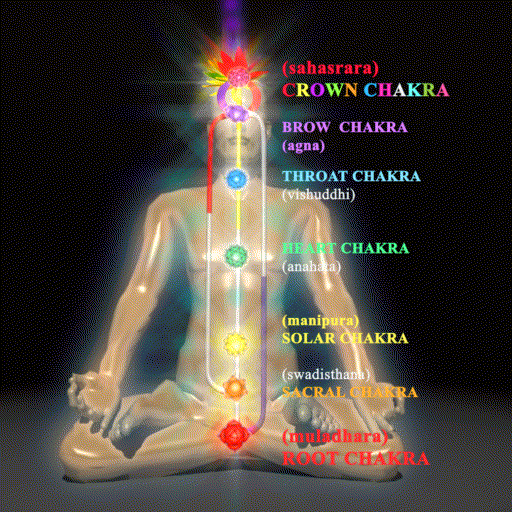
1. Tadasan
 Stand on the toes. Chant “Bhuh” (bhooh) and raise both the hands upward while inhaling gradually and deeply. Look upwards to the sky.(All the four actions should take place simultaneously). Hold your breath inside. This exercise helps adequate blood supply in the heart, stretching the spine backwards and thus giving it the much-needed rest. This practice instantly removes lethargy. It is also beneficial in the case of weakness of the heart and blood disorders.
Stand on the toes. Chant “Bhuh” (bhooh) and raise both the hands upward while inhaling gradually and deeply. Look upwards to the sky.(All the four actions should take place simultaneously). Hold your breath inside. This exercise helps adequate blood supply in the heart, stretching the spine backwards and thus giving it the much-needed rest. This practice instantly removes lethargy. It is also beneficial in the case of weakness of the heart and blood disorders.
2. Pad Hastasana
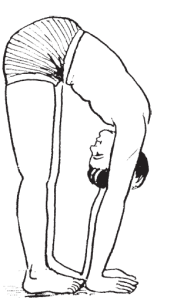 Chanting “Bhuvah”, bring both the hands downward from the posture of tadasan and exhale at the same slow and consistent pace and bow the head down to touch the knees, also attempt making the palms touch the floor. Hold your breath out for several seconds and come back to the normal standing posture. Practice of this asana removes gastric trouble and induces vital strength in the Ida , Pingala, and Susumna Nadis. (See the Chapter 5 for introduction to the term nadi). It also helps reducing fat on the tummy and increasing the flexibility of the spinal cord.
Chanting “Bhuvah”, bring both the hands downward from the posture of tadasan and exhale at the same slow and consistent pace and bow the head down to touch the knees, also attempt making the palms touch the floor. Hold your breath out for several seconds and come back to the normal standing posture. Practice of this asana removes gastric trouble and induces vital strength in the Ida , Pingala, and Susumna Nadis. (See the Chapter 5 for introduction to the term nadi). It also helps reducing fat on the tummy and increasing the flexibility of the spinal cord.
3. Vajrasan
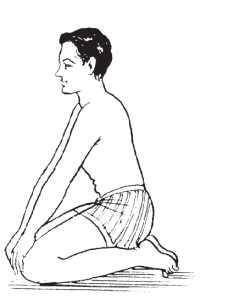 With the chant of “Swah”, place the toes completely on the floor and set the haunches on the feet. Both the legs should be in closed contact. Keep the backbone erect and place the palms on the knees. Breathe normally during this posture. The back, neck and head should remain straight. Practising this asan for few minutes every day is helpful in maintaining good digestion and curing gastric trouble and constipation. It strengthens the muscles around stomach and protects from the problems of hernia. Blood supply to the stomach and uterus is finetuned by this practice.
With the chant of “Swah”, place the toes completely on the floor and set the haunches on the feet. Both the legs should be in closed contact. Keep the backbone erect and place the palms on the knees. Breathe normally during this posture. The back, neck and head should remain straight. Practising this asan for few minutes every day is helpful in maintaining good digestion and curing gastric trouble and constipation. It strengthens the muscles around stomach and protects from the problems of hernia. Blood supply to the stomach and uterus is finetuned by this practice.
4. Ushtrasan
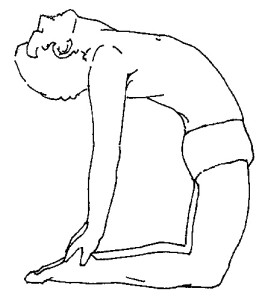 Now get up slightly from the vajrasan with a chant of “Tat”. Stand on your knees with the toes touching the floor and the heels facing backwards. Almost simultaneously, bend backwards to place the palms on the heels from the backside. Inhale deeply while looking upwards. This will inflate your chest. Hold the breath in for few seconds. This asana stretches the abdomen, stomach, chest, and hands in a balanced way. Practice of this asana helps healing the problems of backache and bending of waist/lumber bones etc. It makes the heart strong and augments the natural elasticity of the spinal column. This also provides exercise to muscles of the genital organs. It is a pre-requisite for higher level yoga practices of activating the Ida, Pingla and Sushumna.
Now get up slightly from the vajrasan with a chant of “Tat”. Stand on your knees with the toes touching the floor and the heels facing backwards. Almost simultaneously, bend backwards to place the palms on the heels from the backside. Inhale deeply while looking upwards. This will inflate your chest. Hold the breath in for few seconds. This asana stretches the abdomen, stomach, chest, and hands in a balanced way. Practice of this asana helps healing the problems of backache and bending of waist/lumber bones etc. It makes the heart strong and augments the natural elasticity of the spinal column. This also provides exercise to muscles of the genital organs. It is a pre-requisite for higher level yoga practices of activating the Ida, Pingla and Sushumna.
5. Yogamudra
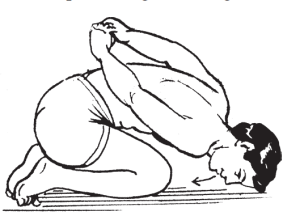 (Remember, the breath was hold inside during the ushtrasan!). With the chanting of “Savitur”, exhale slowly and sit on your legs as in vajrasana at the same time, clench together both the palms at the back and stretch upwardly and place the head on the floor so that the chest and the stomach touch the thighs. Hold the breath out for few seconds This posture further helps curing severe gastric troubles, setting the metabolic activities right and increasing the appetite. It is recommended in advanced yoga practices of awakening the extrasensory energy nucleus called mañipurita chakra beneath the naval.
(Remember, the breath was hold inside during the ushtrasan!). With the chanting of “Savitur”, exhale slowly and sit on your legs as in vajrasana at the same time, clench together both the palms at the back and stretch upwardly and place the head on the floor so that the chest and the stomach touch the thighs. Hold the breath out for few seconds This posture further helps curing severe gastric troubles, setting the metabolic activities right and increasing the appetite. It is recommended in advanced yoga practices of awakening the extrasensory energy nucleus called mañipurita chakra beneath the naval.
6. Ardh Tadasan
 Chanting “Vareñyam”, inhale deeply. Being seated in the posture of vajrasan, raise both the arms and eyes upwards. Hold the breath inside and stretch the arms as much as you can without pain. Focus your eyes on the hands. This asan gives a natural and mild traction to the neck and allays the problems, if any, like cervical spondylitis.Likewise tadasan, it increases blood supply to the heart and cures weakness of the heart and blood-flow related disorders.
Chanting “Vareñyam”, inhale deeply. Being seated in the posture of vajrasan, raise both the arms and eyes upwards. Hold the breath inside and stretch the arms as much as you can without pain. Focus your eyes on the hands. This asan gives a natural and mild traction to the neck and allays the problems, if any, like cervical spondylitis.Likewise tadasan, it increases blood supply to the heart and cures weakness of the heart and blood-flow related disorders.
7. Shashankasan
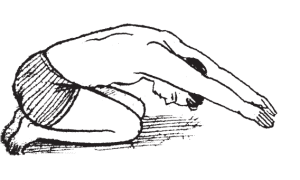 Chanting “Bhargo”, exhale at the same pace as inhalation in the preceding asan. Simultaneously, sit in the posture of vajrasan and keep both the arms stretched outwardly in front of the chest. Place the palms on the floor, bend from the waist to make the stomach touch the thighs and the head touch the floor. The arms should remain straight with palms touching the floor. Hold the breath outside for few seconds. This asan eliminates the problem of constipation and soothingly stretches the muscles within and between the anus and buttock regions. It relaxes the sitica nerves and also helps in regularizing the secretions from the adrenal gland.
Chanting “Bhargo”, exhale at the same pace as inhalation in the preceding asan. Simultaneously, sit in the posture of vajrasan and keep both the arms stretched outwardly in front of the chest. Place the palms on the floor, bend from the waist to make the stomach touch the thighs and the head touch the floor. The arms should remain straight with palms touching the floor. Hold the breath outside for few seconds. This asan eliminates the problem of constipation and soothingly stretches the muscles within and between the anus and buttock regions. It relaxes the sitica nerves and also helps in regularizing the secretions from the adrenal gland.
8. Bhujangasan
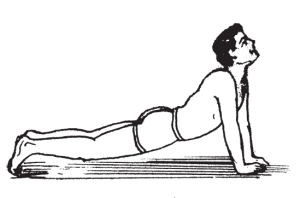 Chanting “Devasya” inhale deeply and pull your waist upwards. Toes and palm should remain at the same place where these were in the previous posture but now the arms should stand straighten. The knees and thighs should touch the floor.Draw your chest and head upwards and raise the head like a snake’s hood. Hold the breath inside and bend the head backwards slightly to stare the sky. This exercise is also recommended as a remedy against cervical spondylitis and several other problems of the spine or back. Apart form providing soothing exercise to the lungs, heart and the backbone, it is especially beneficial for healthy functioning of the liver and kidneys.
Chanting “Devasya” inhale deeply and pull your waist upwards. Toes and palm should remain at the same place where these were in the previous posture but now the arms should stand straighten. The knees and thighs should touch the floor.Draw your chest and head upwards and raise the head like a snake’s hood. Hold the breath inside and bend the head backwards slightly to stare the sky. This exercise is also recommended as a remedy against cervical spondylitis and several other problems of the spine or back. Apart form providing soothing exercise to the lungs, heart and the backbone, it is especially beneficial for healthy functioning of the liver and kidneys.
9. Tiryak Bhujangasan (left)
In the posture of bhujangasan, exhale slowing. Now inhale and with the chant of “Dhimahi” (dheemahi) turn the neck towards the left and try looking at the heel of right foot. Then hold the breath for few seconds. With exhalation bring the head in the front.
10. Tiryak Bhujangasan (right)
Chant “Dhiyo”, inhale and turn the neck towards the right to see the heel of the left foot.Hold the breath for few seconds and bring the head again in the front with exhalation. Practice of the tiryak bhujangasan enhances flexibility of the waist and augments the benefits of the bhujangasan.
11. Shashankasan
Chanting “Yonah” return to the step 7.
12. Ardh Tadasan
Chanting “Prachodayat” repeat step 6.
13. Utkatasan
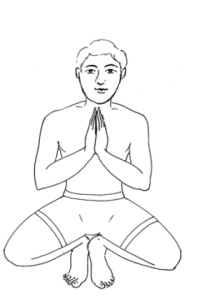 After ardha tadasan in step 12, exhale slowly. Now chant “Bhuh” and with normal breathing sit on the toes. The heels should not touch the floor. Let the calves touch the thighs and knees touch the buttocks. Place both the palms on the knees. Bend the arms on elbows and keep the hands in front of the chest with palms placed on each other in the posture of Namaskar. Back, neck and head should be erect. Breathing should be deep and continued at a consistent pace. This asan gives strength to the calves and improves balance of the body.
After ardha tadasan in step 12, exhale slowly. Now chant “Bhuh” and with normal breathing sit on the toes. The heels should not touch the floor. Let the calves touch the thighs and knees touch the buttocks. Place both the palms on the knees. Bend the arms on elbows and keep the hands in front of the chest with palms placed on each other in the posture of Namaskar. Back, neck and head should be erect. Breathing should be deep and continued at a consistent pace. This asan gives strength to the calves and improves balance of the body.
14. Padhastasan
Chanting “Bhuvah” repeat step 2.
15. Tadasan
Chanting “Swah” repeat step 1.
16. Coming back to original position
With a deep chant of “Om”, inhale slowly and deeply, and stand straight with stretched chest. Place the arms upwards and bend the elbows above the shoulders in a posture as though you are holding a heavy rock on the hands. Hold the breath for few seconds with a feeling that your arms, shoulders, chest and whole body are empowered by new vital force. Now close the fists. Exhale slowly, bring the arms on the sides and stand straight in the posture of attention. Breathe normal in a relaxed mood.
These sixteen steps complete one round of the Pragya Yoga asans. With gradual progress, one may complete 3 to 5 rounds every day. The breathing patterns and chanting of Gayatri Mantra also get perfected with sincerity in daily practice. To a great extent these also offer the benefits of prañayamas. However, if one has time and will or is advised by the yoga teacher to do so, the practice of prañayamas recommended would render great benefits.
If one continues to practice the above asanas aptly and is also sincere in doing prañayamas and Gayatri Meditation every day at suitable timings (preferably early morning), he would get the physical, mental and spiritual benefits of Ashtang Yoga.
Registration
There are many benefits of Asanas but practicing of Asanas is also essential so that one can create a pure light and divinity by releasing the negativity, instability and laziness from body and mind. There are many other benefits too.
To register for Gayatri Gyan Mandir Yoga Class, Please complete and submit the following form:
